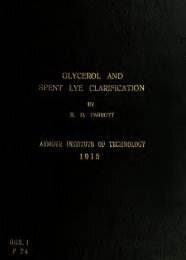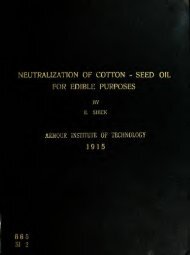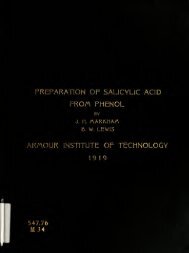View/Open - Illinois Institute of Technology
View/Open - Illinois Institute of Technology
View/Open - Illinois Institute of Technology
You also want an ePaper? Increase the reach of your titles
YUMPU automatically turns print PDFs into web optimized ePapers that Google loves.
I<br />
I ill<br />
IMiaoas <strong>Institute</strong><br />
oiogy<br />
UNIVERSITY LIBRARIES
JAT 439<br />
feurda, J. L.<br />
|The production <strong>of</strong> salol from<br />
phenol
THE PRODUCTION OF SALOL<br />
FROM PHENOL<br />
A THESIS<br />
PRESENTED BY<br />
John L. Burda and Harry B. Richards<br />
TO THE<br />
PRESIDENT AND FACULTY<br />
OF<br />
ARMOUR INSTITUTE OF TECHNOLOGY<br />
FOR THE DEGREE OF<br />
BACHELOR OF SCIENCE<br />
IN<br />
CHEMICAL ENGINEERING<br />
MAY 31, 1917<br />
ILLINOIS INSTITUTE OF TECHNOLOGY<br />
PAUL V. GALVIN LIBRARY<br />
35 WEST 33RD STREET<br />
APPROVED<br />
\^'<br />
%<br />
^thS^^SS^T<br />
',Cj<br />
Dean -f £*£»», s.ud ie .<br />
CHICAGO, IL 60616 frTfc?- I<br />
Dran uf Cultural Studi.
PREFACE.<br />
SALOL is a pharmaceutical product <strong>of</strong> very wide<br />
application and high value. It is not produced to any<br />
great extent in this country. Altho there have been<br />
several methods suggested for the production <strong>of</strong> salol,<br />
particularly in the old German patents, yet the inform-<br />
ation concerning them is very meager* and there is only<br />
one standard commercial method for the production <strong>of</strong><br />
this ohemical compound.<br />
In this thesis the old methods will be investigated<br />
more thorcly and an attempt will be made, if possible,<br />
to suggest and investigate a new method-<br />
The authors wish to express their thanks and<br />
appreciation to Pr<strong>of</strong>. H- McCormack and to Pr<strong>of</strong>.<br />
B« Freud for their kind suggestions anil help <strong>of</strong>fered<br />
in the preparation <strong>of</strong> this thesis.<br />
£7223<br />
Armour <strong>Institute</strong> <strong>of</strong> <strong>Technology</strong>.<br />
Chicago, 111*<br />
May 26, 1917.<br />
/>**<br />
/e=P /(-6C^,(^t/--o
TABLE OF CONT ENTS*.<br />
PREFACE 1<br />
INTRODUCTION 4-<br />
Properties and Use <strong>of</strong> Salol 4.<br />
Theoretical Formation <strong>of</strong> Salol<br />
from Phenol 5 •<br />
Purpose <strong>of</strong> Thesis 5<<br />
GENERAL METHODS FOR THE PRODUCTION OF SALOL.<br />
Production <strong>of</strong> Salol from Salicylates. • • 6.<br />
Production <strong>of</strong> Salicylates from Phenol* •<br />
EXPERIMENTAL DETERM I NATION OF:<br />
Production <strong>of</strong> Salicylates from Phenol.<br />
By the use <strong>of</strong> phosgene 12<br />
By means <strong>of</strong> phenyl carbonate 12«<br />
By the Reimer-Tiemann reaction 17.<br />
By the Marasse process* ••••• •<br />
«<br />
8-<br />
.....19.<br />
By the Kolbe-Schraitt process 20.<br />
-2-
Production <strong>of</strong> Salol from Salicylates*<br />
With chlorides <strong>of</strong> phosphorus<br />
With phosgene<br />
With phosphorus pentoxide<br />
With acid sulfates<br />
Inferences<br />
THE B. iiND R. SUGGESTED NEW METHOD<br />
Foreword<br />
Apparatus<br />
Method <strong>of</strong> Procedure<br />
Data<br />
Calculations<br />
Discussion<br />
COMMERCIAL APPLICATION<br />
CONCLUSION<br />
APPENDIX<br />
•<br />
-3-<br />
•<br />
21.<br />
22.<br />
82.<br />
23-<br />
23.<br />
25<<br />
25.<br />
25.<br />
26.<br />
28.<br />
30.<br />
31-<br />
33.<br />
34-<br />
35-
INTRODUCTION -<br />
The name SALOL is <strong>of</strong>ten used to mean the<br />
compounds formed by the condensation <strong>of</strong> a substi-<br />
tuted phenol with a substituted hydroxy-acid*<br />
Commercially* however* the name SALOL is applied<br />
to the phenyl ester <strong>of</strong> salicycio acid* The empirical<br />
formula <strong>of</strong> this compound is C13H10O3' and its<br />
structural formula u, 0ax).<br />
Salol is a white* colorless* almost tasteless<br />
body orystallizing in rhombic plates* It melts at<br />
42*5°C« It is very soluble in hot alcohol* insoluble<br />
in water* and soluble in most <strong>of</strong> the organic solv-<br />
ents* (See Appendix)* An alcoholic solution <strong>of</strong><br />
salol is colored violet by the addition <strong>of</strong> neutral<br />
ferric chloride solution* This test is also<br />
characteristic <strong>of</strong> phenol and salicylic acid; salol<br />
may be separated from these by extraction with hot<br />
and cold water and sodium bicarbonate solution*<br />
Salol is used extensively in pharmaceutical<br />
preparations as antirheumatic and antipyretic*
THEORETICAL FORMATION OF SALOL FROM PHEHOL<br />
From the study <strong>of</strong> the structure <strong>of</strong> salol<br />
it is evident that if this body is to be<br />
produced from phenol » f j * a carboxyl group<br />
must be attached to the nucleus <strong>of</strong> the ring in<br />
ortho- position to the OH group »<br />
giving ortho-<br />
hydroxy- benzoic acid» which must be subsequently<br />
esterified with phenol*<br />
The purpose <strong>of</strong> f-is thesis is the investigation<br />
<strong>of</strong> the various methods for the insertion <strong>of</strong> the<br />
carboxyl group as indicated above* and the esteri-<br />
fication <strong>of</strong> the new body, and the determination <strong>of</strong><br />
the most efficient and practical method for the<br />
commercial preparation <strong>of</strong> salol from phenol*<br />
-5-<br />
•<br />
»
GENERA1L METHODS FOR THE PRODUCTION OF SALOL*<br />
BRODUCTION OF SALOL FROM SALICYLATES*<br />
] ) 2 )Z)<br />
Salol was first introduced by v©n Nencki <strong>of</strong><br />
4)<br />
Berne and patented in United States and Germany-<br />
He prepared it by the action <strong>of</strong> ohlorides and<br />
oxychlorides <strong>of</strong> phosphorus on a mixture <strong>of</strong> salicylic<br />
acid or salicylates* and phenol*<br />
Eckenroth has shown that it may be obtained<br />
possibly more economically by the action <strong>of</strong> phosgene<br />
on a mixture <strong>of</strong> sodium salicylate and sodium phenate*<br />
Byk substitutes a mixture <strong>of</strong> phosphoric anhy-<br />
6)<br />
dride and phosphoric acid for phosphoric oxychloride*<br />
Emert heats salicylio acid at 220°C* in an<br />
7)<br />
atmosphere <strong>of</strong> carbon dioxide*<br />
Salol has also been prepared by the interaction<br />
8)<br />
<strong>of</strong> polysalicylide and phenol*<br />
According to Bakunin salol is formed by the<br />
action <strong>of</strong> phosphorus pentoxide on phenol and a<br />
2)<br />
solution <strong>of</strong> salicylic acid in chlor<strong>of</strong>orm •<br />
-6-
Salol can Iso be produced by the action <strong>of</strong><br />
s; '<br />
barium acetate on sal icyl-phenyl- ethyl acid*<br />
In the original von Nencki's process sulfuryl<br />
chloride » thionyl chloride* and acid sulfates <strong>of</strong> the<br />
alkali metals may be used as the dehydrating agents*<br />
The product obtained by these methods is<br />
usually steam distilled and purified by recrystalli-<br />
zation from alcohol*<br />
-7-
PRODUCTION OP SALICYLATES FROM PHEHOL*<br />
All <strong>of</strong> the methods described above require<br />
salicylic acid or its sodium salt- Let us therefore<br />
consider some methods for the preparation <strong>of</strong> these<br />
bodies from phenol*<br />
The standard method for the manufacture <strong>of</strong><br />
salicylic acid is known as Kolbe's process* with<br />
modification by Schmitt* It consists primarly in<br />
the conversion <strong>of</strong> phenol into sodium phenate with<br />
careful drying to remove all traces <strong>of</strong> water • and<br />
a subsequent saturation with carbon dioxide at a<br />
temperature <strong>of</strong> 110°C* » gradually raised to 200°C*«<br />
and kept constant at that temperature for several<br />
hours* As a result <strong>of</strong> this treatment 50J& <strong>of</strong> the<br />
original phenol is converted to sodium salicylate*<br />
The reactions involved may be indicated as follows:<br />
CgHgOH + NaOH-» CgHgOKa i- HgO* (l)<br />
CgH 5 ONa+ C0 2 -*> C6 H 5 O.COONa -at 110°C (2)<br />
Of*- 0;t<br />
-OH<br />
OAk -at 110°_200°C(3)<br />
O<br />
Kj-^OtK + °6H 5 0Na ^I^A^G 6 H 5 0H. (4)<br />
;
In order to convert all <strong>of</strong> the phenol into<br />
sodium salicylate. Schmitt's modification <strong>of</strong> this<br />
process must be employed. It consist s <strong>of</strong> preparing<br />
sodium phenyl carbonate as in Kolbe's process* and<br />
heating this product in an autoclave under pressure<br />
at 140°C- Instead <strong>of</strong> preparing sodium phenyl carbon-<br />
ate with gaseous carbon dioxide, the sodium phenate<br />
may be mixed directly with liquid or solid carbon-<br />
dioxide in the autoclave and heated under pressure*<br />
In Schmitt's process equation (3) takes place but is<br />
not followed by equation (4), whereby all phenol is<br />
converted into the salicylate*<br />
Some other processes for the preparation <strong>of</strong><br />
salicylates which might serve as the basis for the<br />
preparation <strong>of</strong> salol are:<br />
Marasse's process consists <strong>of</strong> heating an intimate<br />
mixture <strong>of</strong> phenol and potassium carbonate, and<br />
treating the product with the requisite quantity<br />
<strong>of</strong> carbon dioxide.<br />
-9-
According to Reimer and Tiemann salicylic<br />
aoid is formed together with para-hydroxy-benzoic<br />
acidt the latter predominating, when an alkaline<br />
solution <strong>of</strong> phenol is boiled with carbon tetra-<br />
chloride' The reaction is:<br />
CgH 5 OH + 5NaOH + OCI4 ->C6H4(0H)000Naf 4NaCl<br />
+ 3HgQ.<br />
Sodium salicylate may also be prepared by the<br />
fusion <strong>of</strong> phenyl oarbonate and sodium hydroxide<br />
at 200°C. 9 ^<br />
(06H50)gOO + NaOH -^ C6H4(0H)000Na+ C6H5OH.<br />
Another method for the preparation <strong>of</strong> sodium<br />
salicylate is attained by passing phosgene into<br />
a solution <strong>of</strong> sodium carbonate and sodium phenate*<br />
-11-
EXPERIMENTAL DETERMINATION OF THE PRODUCTION<br />
BY THE USE OF PHOSGENE.<br />
SALICYLATES FROM PHENOL:<br />
This method which consists <strong>of</strong> the treatment<br />
<strong>of</strong> sodium phenate and sodium carbonate with<br />
phosgene may be represented as follows:<br />
2C 6 H g 0Na 4 COClg - (C 6 H 5 0) 2 CO + 2NaCL<br />
(C 6 H 5 0) g CO + Na 2 C0 3 -^ 2(C 6 H 4 0H.C0.0Na).<br />
Altho theoretically possiblet this reaction<br />
has not been applied on a commercial scale*<br />
Probably the difficulties involved are similar<br />
in nature to those involved in the phenyl carbonate<br />
process described below; the authors <strong>of</strong> this thesis<br />
however, regret very much that the short allowance<br />
<strong>of</strong> time did rot permit them to investigate this<br />
method more thoroly*<br />
BY MEANS OF PHENYL CARBONATE*<br />
According to this process, sodium salicylate<br />
is formed by the action <strong>of</strong> phenyl carbonate and<br />
sodium hydroxide at 200°C« Phenyl carbonate can be<br />
made by allowing phosgene to react with a solution<br />
<strong>of</strong> sodium phenate-<br />
-12-
2C6H50Na + COCI2-* (C6H40)gCO -f 2NaCl«<br />
The first problem involved is the production<br />
<strong>of</strong> phenyl carbonate* This substance is not made<br />
commercially and would therefore have to be prepared<br />
at the plant*<br />
Perhaps the best method for making phenyl<br />
carbonate is the one indicated above. This together<br />
with the subsequent reaction for the formation<br />
<strong>of</strong> the salicylate has been studied by the authors<br />
in the following manner<br />
J<br />
Apparatus A round bottom flask, (500 cc)<br />
was placed on a sand bath and attached to an<br />
upright condenser. (See fig. 1») The top <strong>of</strong> the<br />
condenser Was fitted with a stopper containing a<br />
dropping funnel and an exit tube* The exit tube<br />
was connected to a safety bulb attached to a tube<br />
leading to the reacting flask- The reacting flask<br />
was a 500 cc« Florence flask fitted with a stopper,<br />
thermometer* inlet tube and an exit tube* The<br />
exit tube from the reacting bulb was led to a<br />
bottle containing some solvent such as benzol or<br />
water for the absorption <strong>of</strong> excess <strong>of</strong> phosgene*<br />
-13-
Fife. 1-
Method <strong>of</strong> Procedure? Sixty three grams <strong>of</strong> sodium<br />
hydroxide were dissolved in 80 cc« <strong>of</strong> water , and<br />
treated with 150 grams <strong>of</strong> phenol in an evaporating<br />
dish. The product was heated until a film <strong>of</strong> crystals<br />
began to form- The separated crystals were dissolved<br />
by the addition <strong>of</strong> more water and the concentrated<br />
sodium phenate solution was transferred to the<br />
reacting flask-<br />
Hundred cc <strong>of</strong> carbon tetrachloride were then<br />
placed in the generating flask and fuming sulfuric<br />
acid added, drop by drop thru the tap funnel to the<br />
oarbon tetrachloride kept at a boiling temperature-<br />
The phosgene thus generated was absorbed in the<br />
reacting flask-<br />
After 2^ hours three distinct layers were formed<br />
in the flask; a solid crystalline, grayisbwhite body;<br />
a yellowish brown oily liquid on top <strong>of</strong> an aquaeous<br />
solution. On a continued passage <strong>of</strong> phosgene<br />
effervescence began to take place, showing that<br />
phosgene was being passed in an excess sufficient<br />
to overcome the alkalinity <strong>of</strong> the solution:<br />
C0Cl2*-H 2 0-»-HClt COg.<br />
HC11- (C 6 H 5 ) 2 C0 3 -^ C0 2 +2C 6 H 5 CH- HgO.<br />
-14-
The three layers in the vessel were separated.<br />
The solution was decanted from the crystals which<br />
were then filtered- The solutions were separated from<br />
each other in a separatory funnel. The aquaeous<br />
solution was evaporated to the formation <strong>of</strong> phenyl<br />
carbonate crystals. By fractional crystallization,<br />
the phenyl carbonate crystals were separated from the<br />
mother liquor and added to the original crop <strong>of</strong><br />
crystals from the flask.<br />
The oily layer was distilled. The distillate<br />
consisted mainly <strong>of</strong> phenol* together with a little<br />
water. A very small film <strong>of</strong> coloring matter remained<br />
behind in the distilling flask. The phenol recovered<br />
weighed about 85 grams. » which means that only<br />
about 5056 <strong>of</strong> the original phenol was converted.<br />
The supposed phenyl carbonate was fused with<br />
conc« Na6H solution in an atmosphere <strong>of</strong> COg for<br />
several hours. The resultant product showed no test<br />
for salicylates but a high corcentration <strong>of</strong> carbonates-<br />
The solution on the addition <strong>of</strong> cone HC1 effercesced<br />
briskly, and a crystalline body (NaCl?) separated on<br />
the addition <strong>of</strong> sufficient amount <strong>of</strong> HOI. The solubility<br />
<strong>of</strong> this body in water indicates the absence <strong>of</strong><br />
salicylic acid.<br />
-15-
Discussion: From the results obtained it is<br />
evident that either there was no phenyl carbonate<br />
formed in the first part <strong>of</strong> the opera+ion, or that<br />
on treatment with caustic NaOH at a high temperature<br />
a decomposition <strong>of</strong> the phenyl carbonate sccurred with<br />
the lbss <strong>of</strong> phenol and the formation <strong>of</strong> sodium carbonate-<br />
Perhaps the first investigator <strong>of</strong> this reaction<br />
obtained some salol by careful control <strong>of</strong> the con-<br />
ditions* The reaction does not seem applicable, howev er.<br />
to commercial use«<br />
REIMER AKD II BORN REACTION<br />
In this process a mixture <strong>of</strong> ortho- and<br />
para-hydroxy-benzoic acids is obtained* The<br />
para- hody* however* predominates* According to<br />
Kupferberg* the sodium salt <strong>of</strong> para-hydroxy-<br />
benzoio acid when heated al 290°C* is converted<br />
to the ortho- body. If this rearrangement is<br />
possible commercially* then the reaction would<br />
<strong>of</strong>fer great possibilities for the production <strong>of</strong><br />
salicylates* For this reason the writers have<br />
carefully investigated the problem*<br />
-17-
Method <strong>of</strong> Procedure* Molecular quantities<br />
in grams, <strong>of</strong> phenol » sodium hydroxide, and<br />
carbon tetrachloride were heated together in an<br />
evaporating dish to dryness* The resultant body<br />
was orystalline (in plates). Ferric chloride<br />
test failed to show the presence <strong>of</strong> orthc-hydroxy-<br />
benzoic acid or <strong>of</strong> phenol. Evidently all <strong>of</strong> the phe-<br />
nol present had been converted to the para- body*<br />
The dry product was then heated in an iron<br />
retort in an atmosphere <strong>of</strong> CO,, below 300°C«<br />
After some time phenol began to distill over and<br />
continued to do so. After heating for one hour<br />
the product was again tested with ferric chloride,<br />
and failed to reveal the ortho- hydroxy benzoic acid*<br />
Discussion: Since phenol distilled over,<br />
and the residue in the retort effervesced upon<br />
treatment with dilute hydrochloric acid, the<br />
residual body must have been a carbonate <strong>of</strong><br />
sodium. Perhaps under better regulation <strong>of</strong> con-<br />
ditions, or the use <strong>of</strong> an autoclave, a conversion<br />
to the ortho- body may be obtained- The tendency<br />
<strong>of</strong> the oxybenzcic acids to decompose at temperatures<br />
above 200°C- into phenol and 00g , is too great<br />
to justify the process, add the yield <strong>of</strong> the ortho-<br />
body in the Reimer and Tiemann reaction is alto-<br />
gether too small to render the process applicable.<br />
-1.8-
MARASSE PROCESS.<br />
Owing to the high price <strong>of</strong> potassium com-<br />
pounds* this reaction was studied in view <strong>of</strong><br />
substituting sodium for potassium in its com-<br />
pounds* In this irstance the reaction ought to be;<br />
206H 5 OH -f- Na 2 C0 3 H- C0 2 -» 2C6H4(0H)C00Na*<br />
Method <strong>of</strong> Prooedurel Fifty grams <strong>of</strong><br />
phenol and 56 grams <strong>of</strong> sodium carbonate were<br />
fused in a flask in an atmosphere <strong>of</strong> CO- for<br />
several hours* Ferric chloride test showed the<br />
absence <strong>of</strong> salicylates*<br />
Discussion; Marasse's process employing<br />
KpCO, is a patented process, and would^ applicable<br />
it it were not' for the high cost <strong>of</strong> the raw<br />
materials- According to the above results* the<br />
substitution <strong>of</strong> the sodium carbonate for the<br />
potassium carbonate does not seem to bring about<br />
the desired reaction.<br />
-19-
KOLBE * SCHMITT PROCESS.<br />
This process has already been fully described<br />
in a previous chapter* It furnishes us with<br />
pure salicylic acid or salicylates which are<br />
subsequently used for the production <strong>of</strong> salol*<br />
Since this is the standard commercial process, the<br />
writers have made no attempts to study it further*<br />
From the results <strong>of</strong> the above experiments,<br />
made upon the other suggested methods for the<br />
preparation <strong>of</strong> salicylates, it is quite evident<br />
that the Kolbe - Schmitt process, as cow commercial-<br />
ly applied is by far the most efficient <strong>of</strong> all*<br />
Assuming now that we can obtain salicylates<br />
or salicylic acid commercially, let us consider<br />
some methods for the production <strong>of</strong> SALOL from<br />
these bodies*<br />
-20-
PRODUCTION OF SALOL FROM SALICYLATES.<br />
7,1 IK CHLORIDES OF PHOSPHORUS.<br />
PQC1 ? i Half molecular quantities in grams<br />
<strong>of</strong> sodium salicylate and phenol and 26 grams <strong>of</strong><br />
phosphorus oxychloride were heated slowly over an<br />
open flame in a flask, with twirling. The mixture<br />
was heated for fifteen minutes until thoroly fused*<br />
The melt was poured into cold water, filtered, washed<br />
and recrystallized from alcohol.<br />
PCI?? Half molecular quantities ir grams<br />
<strong>of</strong> sodium salicylate and phenol were heated in a flask<br />
attached to an upright condenser. Forty eight grams<br />
<strong>of</strong> phosphorus trichloride were added to the mixture<br />
drop by drop thru a tap funnel. The mixture was heated<br />
at 135 to 160°;j • for six hours.<br />
PQ1 F ; Molecular quantities <strong>of</strong> salicylic<br />
acid and phenol were heated together in an autoclave<br />
with 50 grams <strong>of</strong> phosphorus pentachloride. The mixture<br />
was allowed to react in the closed autoclave for<br />
one til'Sf hour, and then was heated gradually to a<br />
maximum temperature <strong>of</strong> 128°C. and a pressure <strong>of</strong> 50<br />
lbs. per In2. It was kept under these conditions for<br />
-21-
fifteen minutes- The product had a dark brownish<br />
color* It was decolorized by means <strong>of</strong> animal char-<br />
coal and recrystallized from alcohol*<br />
WITH PHOSGENE .<br />
Molecular proportions <strong>of</strong> salicylic acid and<br />
phenol (69 : 48) in 200 grams <strong>of</strong> benzol were treated<br />
with phosgene in the phosgene apparatus described<br />
before (see fig 1*) at a temperature <strong>of</strong> 76°C* for<br />
five hours* The product failed to show the presence<br />
<strong>of</strong> salol; in fact all <strong>of</strong> the salicylic acid was<br />
recovered*<br />
WITH PpOc;*<br />
This reagent was applied in two different ways-<br />
Forty grams <strong>of</strong> phenol, 60 grams <strong>of</strong> salicylic<br />
acid and 18 grams <strong>of</strong> phosphoric pentoxide were<br />
treated under the same conditions as per POClg<br />
reaction* The melt was poured into cold water,<br />
neutralized with sodium bicarbonate, filtered,<br />
washed , dried and weighed*<br />
-22-
Eighty one grams <strong>of</strong> salicylic acid. 47 grams<br />
<strong>of</strong> phenol and 25 grams <strong>of</strong> phosphoric pentoxide were<br />
heated in an autoclave for forty five minutes at<br />
a maximum temperature <strong>of</strong> 130°C« and a pressure <strong>of</strong><br />
57 pbs. per in. 2 Salol, together with resinous<br />
impurities* was formed'<br />
WITH ACID SULFATES.<br />
Eighty grams <strong>of</strong> sodium salicylate, 47 grams<br />
<strong>of</strong> phenol and 60 grams <strong>of</strong> sodium bisulfate were<br />
heated together in a porcelain evaporating dish<br />
for two hours. There was a great tendency for the<br />
volatilization <strong>of</strong> phenol, even at low temperatures-<br />
The resulting product showed only traces <strong>of</strong> salol.<br />
GENERAL INFERENCES.<br />
The foregoing reactions with phosgene in the<br />
presence <strong>of</strong> benzol. PgOg under pressure. KaHSC>4<br />
in the open, have not given promising results.<br />
T^is may be due either to the particular reagents<br />
used, or to the conditions under which the<br />
operations were carried out*<br />
-23-
The chlorides <strong>of</strong> phosphorus reacting for a<br />
comparatively short length <strong>of</strong> time without pressure,<br />
have shown much better results* Of these POCI3 is<br />
by far the best* In fact POCI3 is used commercially'<br />
Time after complete fusion does not seem to affect<br />
materially the degreee <strong>of</strong> conversion.<br />
Treatment with PpOs without pressure was<br />
quite satisfactory. The yield ^as perhaps not quite<br />
as large as with POCI3 but fee reaction was less<br />
violent, the heat <strong>of</strong> the reaction was smaller<br />
-eliminating the necessity <strong>of</strong> artificial cooling as<br />
applied to the POCI3 treatment-, no pungent fumes<br />
were evolved, and therefore the pentoxide seems to<br />
be a very promising reagent for commercial application-<br />
One <strong>of</strong> the chlorides <strong>of</strong> phosphorus. (PC15), and<br />
the pentoxide were tried upon the reagents under<br />
pressure. The latter cf the two failed to give<br />
satisfactory results, but the pentachloride yielded<br />
a product <strong>of</strong> salol comparable with the product<br />
from the standard treatment* This reaction is later<br />
applied to the B« and R« process-<br />
-24-
Fig* 2«
THE B» AND R. SUGGESTED NEW METHOD.<br />
The foregoing reactions for the preparation<br />
<strong>of</strong> salol all require the production <strong>of</strong> salicylates<br />
from phenol, <strong>of</strong> separation <strong>of</strong> salicylates from<br />
by-products » and the final treatment <strong>of</strong> salicylates<br />
for salol. The B« and R. method is an attempt<br />
towards the simplification <strong>of</strong> all these steps.<br />
It oonsists <strong>of</strong> treating together sodium phenyl<br />
carbonate and phenol or sodium phenate with PGI5<br />
or a similar dehydratin agents* under the proper<br />
conditions <strong>of</strong> heat and pressure*<br />
EXPERIMENTAL APPARATUS.<br />
Carbonating drum; An enclosed W.I. pipe><br />
4 in. dia« ; 24 in. long, provided with inlet and<br />
outlet tubes » a thermometer cup, and an opening<br />
for stirrer. (See fig. 2).<br />
Autoclave: A small copper lined cast<br />
iron autoclave, <strong>of</strong> a about a gallon capacity,<br />
provided with a pressure gauge, thermometer cuP,<br />
and a safety valve. (See fig* 3).
Pig. 3.<br />
&
METHOD OF PROCEDURE.<br />
Molecular proportions <strong>of</strong> phenol- and sodium<br />
hydroxide in a oonoentrated solution were treated<br />
in the usual manner for the production <strong>of</strong> dry<br />
sodium phenate* which was pulverized and further<br />
desiccated in the carbonating drum under vacuum*<br />
A continuous, slow stream <strong>of</strong> COg was allowed to<br />
react upon the dry material in the drum for four<br />
hours* The temperature was kept constant at about<br />
120°C* This is the first part <strong>of</strong> Kolbe's reaction<br />
which gives sodium phenyl carbonate* (c»f» p* 8,<br />
eq* 2). The steel gray sodium phenate was converted<br />
to the reddish brown sodium phenyl carbonate<br />
The resulting material was caked on the<br />
bottom <strong>of</strong> the retort* but could be easily crushed<br />
into a fine powder* It was pulverized and transferred<br />
to the autoclave*<br />
A slight excess <strong>of</strong> phenol was added* the mass<br />
was well stirred and sufficient PC1 C was thrown in<br />
and the autoclave was immediately sealed* Heat<br />
and pressure were then applied for a period <strong>of</strong><br />
three hours under the conditions tahulated on page 28.<br />
-26-<br />
•
When coded to about 60°C«» the mass was<br />
treated with water f cer.trifuged* and the residual<br />
heavy layer was distilled with steam. The yellow<br />
oily liquid distilling over showed all the charac-<br />
teristics <strong>of</strong> salol. Further purification was<br />
abandoned*<br />
-37-
- DATA -<br />
•btained in the experimental run <strong>of</strong><br />
CHARGE FOR CARBON ATI ON.<br />
The B» and R. Process.<br />
Pher.ol • • '200 grar s<br />
Sodiuxr. Hydroxide 82<br />
Sodium pherate obtained<br />
"540<br />
TIME OF CARBONATION 4 hours<br />
CHARGE FOR THE AUTOCLAVE?<br />
Sodium phenyl carbonate °0C grams<br />
Phenol<br />
pci 5<br />
LOG OF OPERATIONS: (See next page).<br />
132<br />
ioo<br />
WEIGHT OF YELLOW DISTILLATE 167 grams-<br />
-28-
LOG OF OPERATIONS:<br />
TIME. TEMPERATURES. PRESSURES-<br />
8:40<br />
8 J 54<br />
8:56<br />
8:57<br />
3:58<br />
9:03
CALCULATIONS:<br />
200 g. NaPhC0 3<br />
» 118 g. Phenol = 265 g. Salol«<br />
Yield <strong>of</strong> crude salol 167 grams*<br />
Estimated loss. 4/S 7<br />
Total possible yield 174<br />
Theoretical yield-<br />
265<br />
Per cent recovery 66f.<br />
-30-
DISCUSSION,.<br />
It is seen from the above data that a yield <strong>of</strong><br />
about 66$ <strong>of</strong> orude salol was obtained* basing calcul-<br />
ations on the amount <strong>of</strong> sodium phe«nyl carbonate used*<br />
This is quite hopeful, as there are many conditions<br />
<strong>of</strong> the process which are open for improvement'<br />
It was assumed that the sodium phenate in the experi-<br />
ment was completely carbonated* which might not have<br />
been the case. The yield <strong>of</strong> salol is directly propor-<br />
tional to the degree <strong>of</strong> oarbonatior <strong>of</strong> the sodium<br />
phenate« Complete oarbonatior may be had under proper<br />
plant operations-<br />
Phosphorus p°ntachloride was used in the experi-<br />
mental work due to the convenience in handling, but<br />
this is not sufficient reason for the elimination <strong>of</strong><br />
other dehydrating agents which have not been tried-<br />
The authors regret that lack <strong>of</strong> time prevented a further<br />
study <strong>of</strong> other condensation reagents, particularly<br />
Pool, and likewise the determination <strong>of</strong> proper time,<br />
temperature and pressure conditions-<br />
-31-
It is the writers sincere belief that salol<br />
can be produced by th©. above method on a commercial<br />
scale, provided that the proper conditions are pre-<br />
determined*<br />
The advantages <strong>of</strong> this method are:<br />
The combination <strong>of</strong> the A gaolecu^e <strong>of</strong> sodium phenyl<br />
carbonate and the condensation reaction into<br />
one step;<br />
the elimination <strong>of</strong> the necessity for pure salicylates<br />
as raw material;<br />
the total elimination <strong>of</strong> salicylates from the process;<br />
the possibility <strong>of</strong> using gaseous COg from any available<br />
souroe without the neoessity <strong>of</strong> resorting to<br />
liquid COg. which is essential to the Schmitt's<br />
rapid process*<br />
-3P-
COMMERCIAL APPLICATION'<br />
Under present conditions even the yield<br />
experimentally obtained would render the process<br />
commercially applicable*<br />
Sbout fifty pound lots <strong>of</strong> sodium phenate can<br />
be oarbonated in suitable apparatus and the sodium<br />
phenyl carbonate with an additional amount <strong>of</strong> phenol<br />
and a suitable dehydrating agent heated under pressure<br />
to the formation <strong>of</strong> salol* The resulting mass is<br />
allowed to cool partially and treated with a rapid<br />
stream <strong>of</strong> a sodium bicarbonate solution. It is then<br />
allowed to settle and the heavy layer is drained <strong>of</strong>f<br />
and distilled with steam. The distillate is again<br />
allowed to settle; the oily layer is then washed,<br />
dissolved in acetone or alcohol and crystallized from<br />
the solvent* which can be recovered by distillation*<br />
The details <strong>of</strong> the manufacturing operations<br />
can not be outlined here*<br />
-33-
CONCLUSION.<br />
To summarize briefly* the work <strong>of</strong> this thesis<br />
oomprised the following researches:<br />
the thoro study <strong>of</strong> the theoretical formation <strong>of</strong><br />
salol; the experimental study <strong>of</strong> the old processes for<br />
the production <strong>of</strong> salicylates and salol; the determin-<br />
ation <strong>of</strong> the most applicable dehydrating reagents;<br />
and the suggestion and experimentation <strong>of</strong> a new<br />
process for the production <strong>of</strong> salol<br />
It was found that the use <strong>of</strong> phosphorus oxy-<br />
chloride upon salicylates obtained by Schmittys process<br />
is the best commercial process <strong>of</strong> the former proposed<br />
methods. A new method, however, was suggested, which<br />
might prove to be <strong>of</strong> even greater commercial value<br />
than the one in use to-day. Only an outline <strong>of</strong> the<br />
process has been given, together with the manner in<br />
which the experiment was conducted; the determination<br />
<strong>of</strong> further details and actual conditions is left<br />
open for further investigation.<br />
-34-<br />
•
APPENDIX.<br />
SOLUBILITY <strong>of</strong> salol in different solvents expressed<br />
in grams per 100 grams <strong>of</strong> saturated solution* at 25 C*<br />
Solvent'
"IBLIOQRAPHY AND REFERENCES.<br />
1) Thorpe's Dictionary'<br />
2) Bleinstein. II. 1493. 1903 p. 587.<br />
3) Neues Handworterbuch der Chemie* VI. 73-<br />
4) D.R.P. 3S.973, April 23, 1886.<br />
1662 July 21. 1887.<br />
5) D.R.P. 39,184. Aug. 11, 1886.<br />
6) Eng, Pat. 23,449.<br />
7) Eng. Pat- 14,224.<br />
D.R.P- 6.2276.<br />
8) D.R.P. 73,452.<br />
9) Victor von Richter's Organic Chemistry.<br />
II. - 1900. - 224.<br />
10) " "<br />
n<br />
Lexikon der.Kohlenst<strong>of</strong>f<br />
Verbindungen. II.<br />
11) A* Seidell, Solubility <strong>of</strong> Salol in Different<br />
Solvents*<br />
J. Am. Chem. Soc 29. 1089.<br />
-36-













